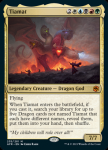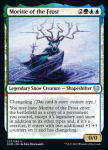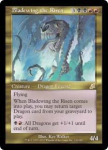Oversoul
The Tentacled One
I love Dream Halls. I don't know where to start. Well, there's a kind of story...
Infamously, back when Stronghold came out, InQuest magazine dismissed Dream Halls as the worst card in the set. They reasoned that it was a liability. You pitch your Llanowar Elves to cast your Verdant Force, then your opponent does the same, except you are the one who paid for the enchantment, so you're behind. Of course, players mostly eschewed such usage of Dream Halls, opting instead to build around the card and chain spells together for combo decks.
In tournament play, this led to TurboZvi.
9 Island
4 Crystal Vein
4 Svyelunite Temple
4 Ancient Tomb
4 Lotus Petal
4 Dream Halls
4 Intuition
4 Meditate
4 Sift
4 Ancestral Memories
4 Mana Severance
4 Memory Lapse
1 Counterspell
1 Impulse
1 Lobotomy
1 Inspiration
3 Gaea's Blessing
Sideboard:
4 Adakar Wastes
4 Abeyance
4 Hydroblast
1 Dismiss
1 Inspiration
1 Lobotomy
The concept of quickly resolving a Dream Halls, then pitching blue cards from your hand to cast card-drawing spells, drawing through most/all of your deck and assembling a kill was potent, and would appear again in later Dream Halls combo decks. In the 1998 Type 2 environment, the kill mechanism was clunky, but effective. Once Dream Halls was resolved, the idea was to pitch blue cards to cast card-drawing spells, find Mana Severance, get those pesky lands all out of the deck (don't need 'em anymore), and then set up a loop with Gaea's Blessing. Once one built up a big enough hand, it became trivial to keep the loop going and to have access to countermagic backup and to Lobotomy. You'd then loop through and Lobotomy away your opponent's entire hand (except basic lands), and next you'd tediously feed your opponent two cards at a time with Inspiration and Lobotomy those away. If the opponent managed to cast a spell by pitching one of the Inspiration draws to cast the other, you'd counter it and Blessing-draw Loop your countermagic back into your hand for next time. Your opponent would be locked down for the turn, drawing two cards at a time, having both removed with Lobotomy unless they were basic lands, and having any instants cast countered by either Counterspell or Memory Lapse. Eventually, you'd kill your opponent by decking with Inspiration.
The success of TurboZvi embarrassed the not-so-prescient folks at InQuest and drew attention to the potential for other Dream Halls combo decks. But as I noted in the Tolarian Academy thread, previous combo decks were eclipsed by the lightning-fast Academy. In Type 2, Academy was quickly banned. Dream Halls decks were built with many of the same components. At the Magic Invitational, a few players used a Dream Halls deck with Meditate, Intuition, Time Spiral, Mind Over Matter, Stroke of Genius, and Mana Vault. The idea was to rush out Dream Halls, pitch blue cards to cast card-drawing spells (especially Time Spiral), and then get both Mana Vault (hardcast) and Mind Over Matter (cast with Dream Halls) on the board. Discarding cards to untap Mana Vault would produce 3 for each card discarded, and with leftover blue mana from Time Spiral, this could cast a big Stroke of Genius, which would provide enough cards for a bigger Stroke of Genius, which would provide enough cards to cast a game-winning Stroke of Genius aimed at the opponent.
In 1999, in the wake of the Dream Halls into Mind Over Matter combo deck displayed at the Magic Invitational, Dream Hall was banned in Type 2, banned in Extended, and restricted in Type 1. But the story of the card doesn't end there...
Infamously, back when Stronghold came out, InQuest magazine dismissed Dream Halls as the worst card in the set. They reasoned that it was a liability. You pitch your Llanowar Elves to cast your Verdant Force, then your opponent does the same, except you are the one who paid for the enchantment, so you're behind. Of course, players mostly eschewed such usage of Dream Halls, opting instead to build around the card and chain spells together for combo decks.
In tournament play, this led to TurboZvi.
9 Island
4 Crystal Vein
4 Svyelunite Temple
4 Ancient Tomb
4 Lotus Petal
4 Dream Halls
4 Intuition
4 Meditate
4 Sift
4 Ancestral Memories
4 Mana Severance
4 Memory Lapse
1 Counterspell
1 Impulse
1 Lobotomy
1 Inspiration
3 Gaea's Blessing
Sideboard:
4 Adakar Wastes
4 Abeyance
4 Hydroblast
1 Dismiss
1 Inspiration
1 Lobotomy
The concept of quickly resolving a Dream Halls, then pitching blue cards from your hand to cast card-drawing spells, drawing through most/all of your deck and assembling a kill was potent, and would appear again in later Dream Halls combo decks. In the 1998 Type 2 environment, the kill mechanism was clunky, but effective. Once Dream Halls was resolved, the idea was to pitch blue cards to cast card-drawing spells, find Mana Severance, get those pesky lands all out of the deck (don't need 'em anymore), and then set up a loop with Gaea's Blessing. Once one built up a big enough hand, it became trivial to keep the loop going and to have access to countermagic backup and to Lobotomy. You'd then loop through and Lobotomy away your opponent's entire hand (except basic lands), and next you'd tediously feed your opponent two cards at a time with Inspiration and Lobotomy those away. If the opponent managed to cast a spell by pitching one of the Inspiration draws to cast the other, you'd counter it and Blessing-draw Loop your countermagic back into your hand for next time. Your opponent would be locked down for the turn, drawing two cards at a time, having both removed with Lobotomy unless they were basic lands, and having any instants cast countered by either Counterspell or Memory Lapse. Eventually, you'd kill your opponent by decking with Inspiration.
The success of TurboZvi embarrassed the not-so-prescient folks at InQuest and drew attention to the potential for other Dream Halls combo decks. But as I noted in the Tolarian Academy thread, previous combo decks were eclipsed by the lightning-fast Academy. In Type 2, Academy was quickly banned. Dream Halls decks were built with many of the same components. At the Magic Invitational, a few players used a Dream Halls deck with Meditate, Intuition, Time Spiral, Mind Over Matter, Stroke of Genius, and Mana Vault. The idea was to rush out Dream Halls, pitch blue cards to cast card-drawing spells (especially Time Spiral), and then get both Mana Vault (hardcast) and Mind Over Matter (cast with Dream Halls) on the board. Discarding cards to untap Mana Vault would produce 3 for each card discarded, and with leftover blue mana from Time Spiral, this could cast a big Stroke of Genius, which would provide enough cards for a bigger Stroke of Genius, which would provide enough cards to cast a game-winning Stroke of Genius aimed at the opponent.
In 1999, in the wake of the Dream Halls into Mind Over Matter combo deck displayed at the Magic Invitational, Dream Hall was banned in Type 2, banned in Extended, and restricted in Type 1. But the story of the card doesn't end there...




